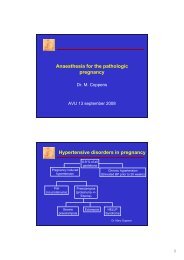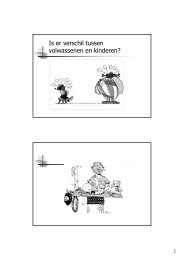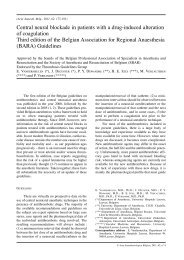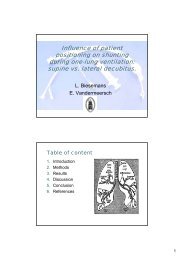Combined spinal epidural analgesia for labor and delivery
Combined spinal epidural analgesia for labor and delivery
Combined spinal epidural analgesia for labor and delivery
Create successful ePaper yourself
Turn your PDF publications into a flip-book with our unique Google optimized e-Paper software.
COMBINED SPINAL EPIDURAL ANALGESIA FOR LABOR AND DELIVERY 111<br />
Table 1<br />
Reliability of <strong>epidural</strong> catheters :% of failed <strong>epidural</strong> catheters<br />
not producing adequate <strong>analgesia</strong> <strong>and</strong> resited<br />
CSE<br />
Epidural<br />
NORRIS 2000 (107) 0.2% 1.3%<br />
COMET 2001 (38) 4.0% 6.8%<br />
VAN DE VELDE 2001 (161) 1.49% 3.18%<br />
THOMAS 2005 (156) 9.3% 8.0% *<br />
CAPPIELLO 2008 (22) 3% 13%<br />
LEE 2009 (86) 1% 6%<br />
MIRO 2008 (98) 3.4% 6.2%<br />
* THOMAS et al. reported more catheter replacement when the<br />
<strong>spinal</strong> component failed (22.2%).<br />
Cesarean section when the catheter was placed as<br />
part of a CSE technique <strong>for</strong> <strong>labor</strong> <strong>analgesia</strong> (86).<br />
When using a CSE technique, a perfect midline<br />
approach is required to identify the subarachnoid<br />
space <strong>and</strong>, consequently, more <strong>epidural</strong><br />
catheters are reliably positioned into the <strong>epidural</strong><br />
space (161). THOMAS et al. interestingly noted that,<br />
when no cerebro<strong>spinal</strong> fluid was obtained following<br />
attempted CSE, much more <strong>epidural</strong> catheters<br />
required replacement subsequently, as compared to<br />
those catheters placed when cerebro<strong>spinal</strong> fluid was<br />
noted (156).<br />
Failed <strong>spinal</strong> component<br />
dose sparing effect also persists during <strong>labor</strong>. The<br />
presence of the dural whole <strong>and</strong> the facilitated passage<br />
of <strong>epidural</strong>ly administered local anesthetics<br />
could offer part of the explanation.<br />
Duration of initial <strong>analgesia</strong><br />
Duration of initial <strong>spinal</strong> <strong>analgesia</strong> is usually<br />
similar to the duration of an initial <strong>epidural</strong><br />
bolus (69, 104, 162). Spinal <strong>analgesia</strong> typically<br />
lasts <strong>for</strong> 90-150 minutes, but a wide variety exists,<br />
depending on the administered <strong>spinal</strong> drugs <strong>and</strong> on<br />
pain modulating factors such as parity, stage of<br />
<strong>labor</strong>, speed of <strong>labor</strong>, etc... (19, 27, 43, 49, 73, 95,<br />
116, 118, 150, 168). In ideal circumstances <strong>and</strong><br />
using multi-drug combinations, <strong>spinal</strong> <strong>analgesia</strong><br />
may last <strong>for</strong> more than 4 hours (43, 116). Several<br />
authors continue the search <strong>for</strong> long lasting <strong>spinal</strong><br />
<strong>analgesia</strong>, hoping that single shot <strong>spinal</strong> <strong>analgesia</strong><br />
would ultimately be achieved. Despite extensive<br />
research, disappointingly, no more (<strong>and</strong> often less)<br />
than 50% of patients deliver during the initial <strong>spinal</strong><br />
<strong>analgesia</strong> (168).<br />
Epidural catheter reliability<br />
Following initial <strong>spinal</strong> <strong>analgesia</strong>, bilateral<br />
<strong>analgesia</strong> <strong>and</strong> sensory changes occur, rendering the<br />
testing of the <strong>epidural</strong> catheter difficult. Hence, one<br />
may question about the reliability of the catheter to<br />
achieve bilateral <strong>analgesia</strong> once the <strong>spinal</strong> dose has<br />
worn off. However, several investigators noted that<br />
the reliability of <strong>epidural</strong> catheters following CSE<br />
is similar or better than st<strong>and</strong> alone <strong>epidural</strong><br />
catheters (22, 38, 86, 98, 107, 109, 156, 161)<br />
(Table 1). They showed less need <strong>for</strong> <strong>epidural</strong><br />
catheter replacement <strong>and</strong> less unilateral <strong>analgesia</strong><br />
requiring catheter manipulation. LEE et al. reported<br />
less catheter failure at the time of topping up <strong>for</strong><br />
Failure to identify the <strong>spinal</strong> space <strong>and</strong><br />
produce good <strong>spinal</strong> <strong>analgesia</strong> is reported in 0-18%<br />
of patients (156). As with every technique, failure<br />
may occur, but, in these instances, the <strong>epidural</strong><br />
catheter can still be used to provide <strong>analgesia</strong>.<br />
Failure of the <strong>spinal</strong> component indicates that the<br />
<strong>epidural</strong> needle is not perfectly situated on the midline<br />
<strong>and</strong> is a risk factor <strong>for</strong> subsequent <strong>epidural</strong><br />
catheter failure (156). In this case, re-positioning of<br />
the <strong>epidural</strong> needle is advocated by this author.<br />
COMPLICATIONS OF LABOR ANALGESIA : CSE ANALGESIA<br />
VS CONVENTIONAL EPIDURAL ANALGESIA<br />
Pruritus<br />
This is the most common side effect of<br />
intrathecal opioids, occurring in almost all patients,<br />
if directly questioned (36, 98, 162, 167). In the most<br />
recent Cochrane review, pruritus was reported more<br />
frequently following CSE <strong>and</strong> was reported to be<br />
the only complication occurring more frequently<br />
than with conventional <strong>epidural</strong> <strong>analgesia</strong> (152). It<br />
usually develops shortly after <strong>analgesia</strong>. It is mild<br />
<strong>and</strong> hardly ever requires antipruritic therapy.<br />
Prophylactic ondansetron is ineffective to reduce<br />
the incidence or severity of opioid induced pruritus<br />
(169). Opioid induced itching is dose-dependent<br />
<strong>and</strong> can be modulated by other adjuvant drugs such<br />
as epinephrine (12, 19). Since patients hardly ever<br />
require therapy <strong>and</strong> seldom report pruritus as a reason<br />
<strong>for</strong> dissatisfaction, pruritus is not a reason to<br />
refrain the use of CSE <strong>and</strong> intrathecal opioids.<br />
Nausea<br />
Nausea <strong>and</strong> vomiting are very rare com -<br />
plications during CSE <strong>and</strong> conventional <strong>epidural</strong><br />
© Acta Anæsthesiologica Belgica, 2009, 60, n° 2
















